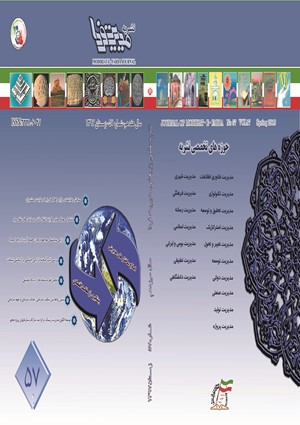Ranking suppliers in sustainable supply chain, using data envelopment analysis (Case study: Region Six Water & Wastewater Company of Tehran)
Subject Areas :Ali Naimi-Sadigh 1 , Arman Sajedinejad 2
1 -
2 -
Keywords: Supply Chain Management, Sustainability, Data Envelopment Analysis, Water and Sewage Company,
Abstract :
The supply chain management debate is one of the most important discussions in the organizations. But there are many social, economic, and environmental problems encouraging organizations to use sustainable supply chain management. Because the sustainable supply chain is to improve the long-term supply chain performance to address the social, economic, and environmental problems of the traditional supply chain. Given that supply chains have grown rapidly in recent years, only paying attention to economic performance for cost optimization cannot lead to sustainable development in the supply chain, therefore, the impact of various activities involved in the supply chain on social life and Environmental issues that lead to sustainable development should also be considered. In this research, the goal of evaluation and ranking of sustainable supply chain suppliers is using the data envelopment analysis method. First of all, using previous studies in this area, we first identify the important variables of choosing sustainable supply chain suppliers according to the economic, environmental and social measures for the District 6 water and sewage company. Subsequently, according to an interview with experts in this area, we reduced the indexes. Finally, DEA models were ranked by the suppliers of sustainable supply chain water and sewage companies in District 6 of Tehran as a statistical population.
1- اصغرپور،محمدجواد. (1387). "تصميم گيری های چندمعیاره " انتشاراتدانشگاه تهران،چاپ پنجم.
2- بهرام، صائب، آزادنیا، امیرحسین، قدیر ، امیرحسین ،مقاله استفاده از تحلیل سلسله مراتبی فازی در انتخاب تأمین کنند در زنجیره تأمین پایدار،1394.
3- جهانشاهلو، غلامرضا، حسین زاده لطفی، فرهاد، نیکومرام، هاشم. (1387). "مقدمه¬ای بر تحلیل پوششی داده¬ها". انتشارات دانشگاه آزاد اسلامی، واحد علوم تحقیقات.
4- کوپر ،ویلیام، کوراتن، ترجمه:میرحسنی،ع.،1387،تحلیل پوششی داده ها مدل ها و کاربرد ها،انتشارات دانشگاه امیر کبیر،چاپ سوم.
5- ماهنامه علمی تخصصی لجستیک و زنجیره تأمی نپایدار ،شماره 34،دی 1393.
6- مصطفی زاده ، مهسا، جعفری ، عزیزاله، ارائه مدل ریاضی چند هدفه برای طراحی شبکه زنجیره تأمین پایدار با در نظر گرفتن مدیریت موجودی ، 1390.
7- موتمنی،ع.،1381،طراحی مدل پویای بهره وری با رویکرد تحلیل پوششی داده ها،رساله دکتری، دانشگاه تربیت مدرس.
8- مهرگان، محمد رضا،.(1383)، مدلهای کمی در ارزیابی عملکرد ساز مان ها (تحلیل پوششی داده ها)، تهران: دانشکده مدیریت.
9- خاتمی فیروز آبادی، سید محمد علی ،الفت ،لعیا ،دولابی، سعید (1394)انتخاب تامین کنندگان در زنجیره تامین پایدار با استفاده از تکنیک های تصمیم گیری چند شاخصه فازی(مطالعه موردی:صنعت قطعه سازی)
10- Al-Odeh, m., & Smallwood, J. (2012). Sustainable Supply Chain Management: Literature Review, Trends , and Framework , vol. 15 Issue 1,2230-7893. IJCEM International journal of omputational Engineering & Management, 15(1.2230-7893).
11- Ashrafi, M. &Chaharsooghi, S. (2011). Criteria for sustainable supplier selection. 2nd international and 4th National Logistics and Supply Chain Conference (pp. 1-17). . 22,23 Nov. Tehran, Iran Logistics. (in Persian)
12- Bai, C., &Sarkis, J. (2010). Integrating sustainability in to supplier selection with grey system and rough set methodologies Int. J. Production Economics. 252-264.
13- Banker RD, Charnes A, CooperWW, Some models for estimatingtechnical a scale inefficiencies in DEA. ManagSci 30(9):1078–1092, 1984.
14- Carter, C., & Easton, P. (2011). Sustainable Supply Chain Management: Evolution and Future Direction. International Journal of Physical Distribution & Logistic Management , 46-62.
15- Carter, C., & Rogers, D. (2008). A framework of sustainable Supply chain management: moving toward new theory. International Journal of Physical Distribution & Logistics Management, 38(5):360-387.
16- Cetinkaya, B., Cuthbertson, R., Ewer, G., klaasWissing, T., Piotrowicz, W., &Tyssen, C. (2011). Sustainable Supply Chain Management: Practical Ideas for Moving towards Best Practice. Springer-verlag Berlin Heidelberg.
17- Charnes. A, Cooper .w.w, Rhodes.E, Measuring the efficiency of the decision making unit, European journal of operation Research 2(6): 429-444, 1987.
18- Daroonparvar, D., Daroonparvar, M., peymandar, M. &Tohidi, N. (2009). Performance assessment of iron manufacturer industries based on the criteria affecting its sustainable development with hierarchical decision-making method in fuzzy environment. Scientific Journal of Management, 6 (Special Issue), 5- 28. (in Persian)
19- Erol, I., Sencer, S., & Sari, R. (2011). A new fuzzy multi criteria framework for measuring sustainability performance of a supply chain. Ecological Economics, 70 , 1088–1100.
20- Govindan, K., Khodaverdi, R., &Jafarian, A. (2013). A fuzzy multi criteria approach for measuring sustainability performance of a supplier based on triple bottom line approach. Journal of Cleaner Production, 345-354.
21- Hsu, C.-W. e. (2011). Using the FDM and ANP to construct a sustainability balanced scorecard for the semiconductor industry. Expert Systems with Applications, 38.12891–12899.
22- Hussain, m. (2011). Modeling The Enablers And Alternativrs For Sustainable Supply Chain Management . Concordia University, A Thesis for the Degree Master of Applied Science(Quality Systems Engineering). The Department of Concordia Institute for In.
23- Kuo, R., & Wang, Y. T. (2010). Integration of artificial neural network and MADA methods for green supplier selection. Journal of Cleaner Production, 18, 1161-1170.


